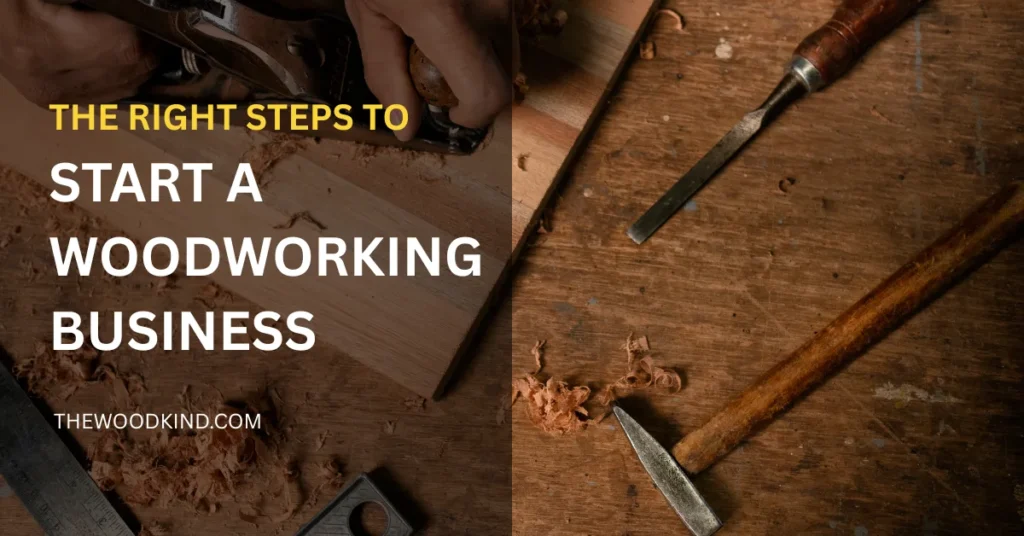The Right Steps To Start a Woodworking Business
If you’ve ever dreamed of turning your passion for woodworking into a thriving business, you’re not alone.
If you like using your hands to make things, woodworking can be more than just fun. It can help you earn money, feel proud, and do things on your own.
In this guide, you’ll learn how to start a woodworking business, from setting up your workshop to selling your products successfully.
Step 1: Plan Your Business
Before you grab your saw and hammer, it’s essential to begin with a business plan. This doesn’t need to be a big business plan. Just write down your goals, who your customers are, what you want to sell, and some simple money plans.
Start by answering these questions:
- What type of woodworking do I enjoy most?
- Will I specialize in furniture, décor, gifts, or outdoor items?
- Who is my ideal customer?
- How much can I realistically produce each week or month?
Having a clear direction helps you focus your energy, tools, and time. Also, consider what sets your woodworking apart. Do you use reclaimed wood? Offer custom engraving? Highlight these elements in your branding.
Step 2: Set Up Your Workspace
You don’t need a large warehouse to start your woodworking business. Many successful woodworkers begin in a garage, shed, or spare room. What you do need is a clean, organized, and well-ventilated space.
Essential tools include:
- Circular saw or table saw
- Drill/driver and bits
- Orbital or belt sander
- Clamps, measuring tools, and squares
- Wood glue, screws, nails, wood filler
Safety gear like goggles, dust masks, and hearing protection is non-negotiable. As your business grows, you can upgrade to more advanced machinery like jointers, routers, and planers.
Step 3: Handle Legal Setup
To operate legally and safely, you’ll need to handle some paperwork. This varies depending on where you live, but some common steps include:
- Registering your business name
- Applying for a local business license or permit
- Getting an EIN (Employer Identification Number) for taxes
- Opening a business bank account
Also, consider liability insurance if you’re selling to the public, especially at markets or online.

Step 4: Create and Test Your Products
This is where your creativity takes center stage. Start small think cutting boards, shelves, jewelry holders, or side tables. These items are faster to build and ideal for learning what your market wants.
Tips for building products:
- Choose high-quality wood like cedar, oak, or maple
- Pay attention to joints, sanding, and finishing
- Aim for a clean, professional look—even on the first try
- Take excellent product photos in natural light
Once you have a few products, ask friends, family, or your online audience for feedback. Use their input to improve your designs before scaling production.
Step 5: Price Your Work for Profit
Pricing is one of the trickiest parts of running a woodworking business. You want your prices to be competitive but also sustainable. Use this simple formula as a starting point:
(Materials + Labor + Overhead) x Profit Margin = Final Price
Let’s break that down:
- Materials: Include wood, screws, glue, finish, etc.
- Labor: Estimate how long each piece takes and assign a fair hourly rate
- Overhead: Include electricity, rent (if any), tool depreciation, and other fixed costs
- Profit margin: Typically 20–50%, depending on demand and uniqueness
Don’t undervalue your time and skills. Well-made wooden items can sell for higher prices, especially if they’re custom or have personal touches.
Step 6: Source Materials Smartly
Wood can be expensive if you’re not careful. Look for creative ways to reduce costs without sacrificing quality.
Where to source wood affordably:
- Local lumberyards (often cheaper than big-box stores)
- Reclaimed wood from construction sites or pallet wood (clean and safe only)
- Craigslist, Facebook Marketplace, or community boards
- Wholesale suppliers, if you buy in bulk
Buying in bulk or partnering with other woodworkers for shared materials can also reduce expenses.
Step 7: Build Your Online Presence
Even if you plan to sell locally, having an online presence boosts your credibility and helps new customers find you.
Start with:
- A simple website or blog with product photos, pricing, and your story
- Social media accounts (Instagram, Pinterest, Facebook) for sharing your builds and behind-the-scenes content
- Optional: Etsy shop, Amazon Handmade, or Shopify store
Focus on SEO-friendly keywords like “custom wood gifts,” “handmade cutting boards,” or “rustic farmhouse shelves.” These terms can help your website show up in Google searches.
Step 8: Sell and Market Your Products
There are several ways to sell your wooden creations:
- Online via your website, Etsy, or social media
- At local craft fairs, markets, or flea markets
- Through word-of-mouth and referrals
- Wholesale to local boutiques or gift shops
Marketing tips:
- Share time-lapse videos of your builds
- Offer limited-time discounts or holiday-themed items
- Run local ads or Facebook promotions targeting nearby homeowners
- Encourage customer reviews and testimonials
The key is consistency. Don’t just post your product once, tell the story behind it, show the process, and build trust with your audience.
Step 9: Stay Organized and Professional
As orders grow, you’ll need systems to track materials, inventory, and finances. Use spreadsheets or apps like QuickBooks, Notion, or Trello to keep things running smoothly.
Also, maintain excellent customer service. Quick replies, accurate delivery estimates, and quality packaging will set you apart and lead to repeat customers.
Final Thoughts
Starting a woodworking business is a fun way to use your skills, be creative, and work for yourself.
While it takes planning, effort, and patience, the rewards can be incredible, both financially and personally.
Whether you’re making cutting boards at home or building furniture in a small space, every woodworking business starts with one piece of wood and a simple idea.
So grab your tools, start building, and let your passion carve the path to success.







